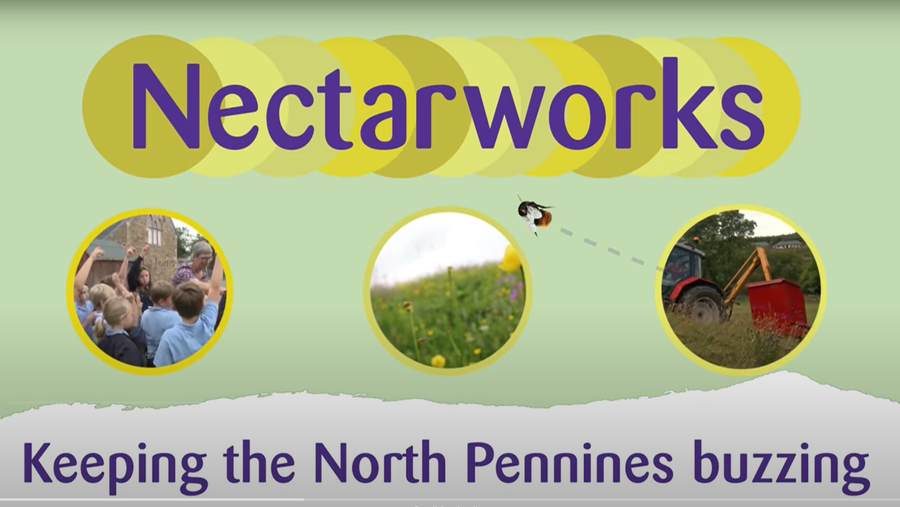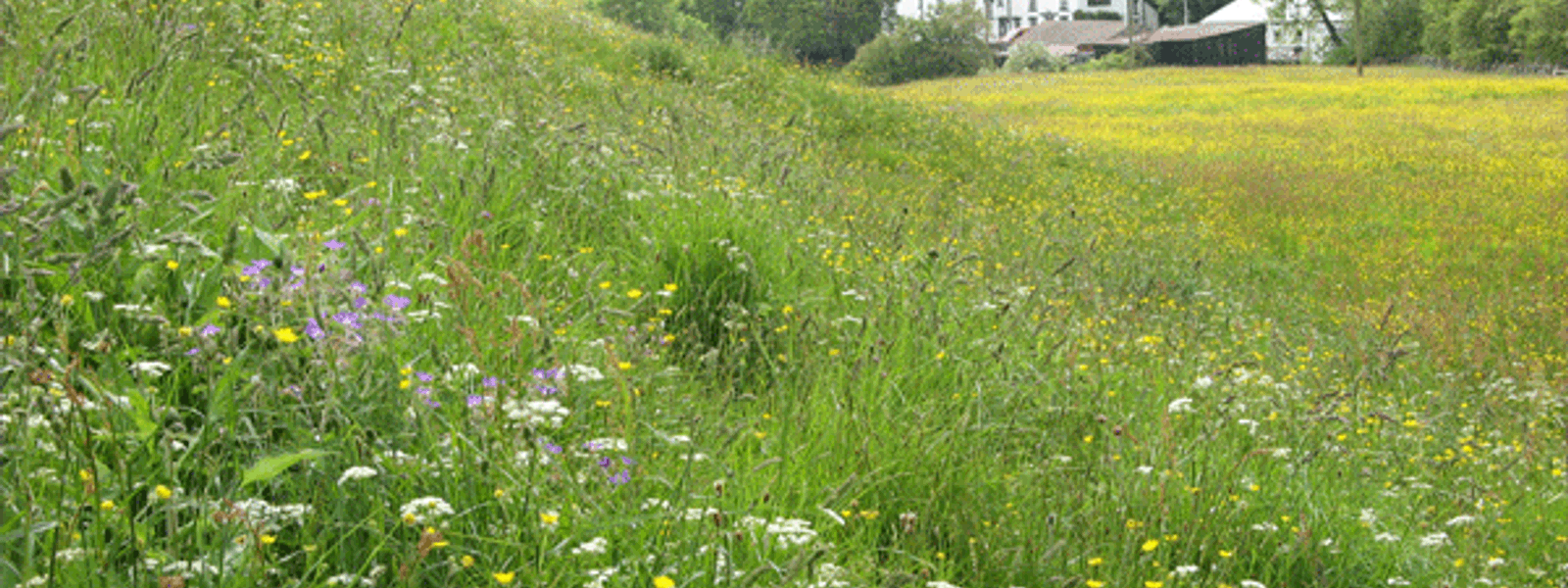Overview
Over the last half century, there has been a catastrophic decline in hay meadows and a corresponding decline in bumblebees. With 40% of the UK’s resource of upland hay meadows and rare invertebrates, we are in a strong position to take action. The North Pennines AONB Partnership’s Nectarworks project focusses on the enhancement, restoration and celebration of flower-rich habitats and the nectar-feeding invertebrates that depend on them. We are proud of our achievements through this project.
We have restored upland hay meadows using new and innovative approaches and engaged with the farmers who manage them. We have facilitated the establishment of a new network for smallholders and generated a host of exciting and fulfilling opportunities for volunteers. We have worked to generate a ground-swell of support amid farmers, volunteers and local residents, young and old and have worked with them to create new nectar gardens within their communities.
What was done
Following the provision of extensive training, we have worked with a team of skilled and enthusiastic volunteers to identify and survey the most flower-rich grasslands in the North Pennines. We also commissioned a specialist survey of nectar-feeding invertebrates of flower-rich habitats. Together, this information has enabled us to engage with farmers to help them further understand the importance of their land for biodiversity.
We have used a unique and specially-commissioned machine to harvest seed from steep banks and road verges, the seed then being spread on nearby meadows as part of a landscape-scale restoration programme. We coupled this with a knowledge-exchange approach with farmers and smallholders to increase understanding of these special habitats and improve the management of them.
Following consultation, we facilitated the establishment of the North Pennines Smallholder Group – a network of enthusiastic local landowners who wish to manage their land to maximise biodiversity. We worked in partnership with them to deliver a suite of training events.
We ran a residential scything training programme to reinvigorate this ancient skill and facilitated community scything events across the North Pennines.
We have developed a GIS-based ‘Nectar-Source Network Map’ which shows the extent and connectivity between different flower-rich habitats across the landscape. This will help target future action for plants and pollinators.
Following annual training in bumblebee identification and garden survey techniques, local volunteers undertook a programme of surveys in residents’ gardens across the AONB. Advice packs were sent to those participating, setting out what was found and top tips for bumblebee-friendly gardening specifically tailored to the harsh conditions of the North Pennines.
We worked in depth with a series of schools across the North Pennines to enthuse, educate and enable the children to take action for bumblebees. As part of this, we created new nectar-rich gardens in their grounds and a teacher pack full of ideas for active enjoyable learning.
We inspired communities and local groups to improve their area for pollinators by creating nectar-rich gardens in community spaces.
Through a programme of enjoyable activities, we inspired people living in residential care homes to take action for pollinators by creating bee-friendly spaces in the grounds.
Having trained volunteers in oral history skills, we enabled them to interview veteran beekeepers from the area. This resulted in a series of fantastic photo films which were launched at a well-received premiere.
We developed an extensive communications programme, including walks, talks, training events, self-guided walk leaflets, mini-films and media coverage.

Keeping the North Pennines buzzing - Nectarworks project summary film.
Outcomes
Throughout the four year project:
We have undertaken botanical surveys of over 250 wildflower-rich places across the North Pennines, inputting the sites into the ‘Nectar-Source Network Map’.
The team of committed volunteer botanists has expanded from an initial dedicated group of 15, to 31 active volunteers. Two training courses have been run each year, training beginner botanists all the way through to skilled surveyors. In total, 38 sites have been surveyed in detail by volunteers, taking soil samples and undertaking over 380 quadrats (1m x 1m squares). The data is being used to assess the importance of flower-rich sites and the management of them, this information is being drawn into a final report
We have harvested seed from flower-rich steep banks and meadows and spread seed on 43 meadows, equalling 133 hectares. The sites have been monitored following the methods set-out during the North Pennines AONB Partnership’s Hay-Time project. Results from the Hay-time project confirm that seed addition is highly successful, increasing wildflower diversity and species-richness. Early indications suggest that we have successfully introduced wildflowers such as wood crane’s-bill and Lady’s-mantles back into the meadows, the final results will be revealed at the end of August 2017
With the help of 20 volunteers, we have hand-collected wildflower seeds, grown plug plants and planted out 3000 wildflower plants into 10 meadows, equalling 20 hectares
We have discussed the management of upland hay meadows and flower-rich places with over 110 local farmers
The North Pennines Smallholder Group (NPS) has expanded to include over 100 smallholders. We have organised and run 15 training workshops, including topics such as meadow management, rush management, bee-keeping and livestock health. There is a well-established Facebook group and website and there is a further summer of workshops lined-up for 2017
We have trained 25 people in the traditional use of a scythe to mow meadows. We facilitated 3 community scything events at a community orchard, a village green and our Bowlees Visitor Centre.
We trained 56 volunteers in bumblebee identification, who collectively surveyed 177 gardens, enthusing residents and inspiring them to create bee-friendly spaces across the AONB
We worked with 875 children in 26 primary schools through creative and active learning and excited them about bumblebees and pollination. We helped 22 schools to create nectar rich gardens in their grounds.
We inspired 7 community groups to improve their area for pollinators by creating nectar-rich gardens including Parish Councils, a community orchard group, Brownies and WI’s.
Through a programme of activities, we enthused people living in 2 residential care homes to help bumblebees by creating nectar gardens in their grounds.
We trained 10 volunteers in oral history skills. These volunteers interviewed 24 veteran beekeepers and summarised or transcribed the recordings. The recordings and transcriptions are now held in the archives at Durham County Records Office for posterity. A local young film-maker used the recordings and the beekeepers own photographs to create 11 poignant photo-films. Over 100 people attended the premiere.
We’ve directly engaged with over 4500 people through our programme of walks, talks and attending events
The project has a strong legacy in terms of:
Continued enhancement of meadows where seed has been added owing to the slow germination and establishment of long-lived perennial plants (as evidenced by our survey data)
Contractors involved in the project now have a new element to their business offer – seed harvesting and spreading using unique harvesting machines
Continuation of the North Pennines Smallholders Group which is now formally constituted and independently run by a team of dedicated committee members
People who we have worked with throughout the project (smallholders, volunteers, schools and community groups) have supported us in the development of a new plug planting project which we have now secured funding for
Ongoing availability of educational resources through the AONB Partnership website coupled with persistence of school and community nectar gardens
Volunteers choosing to continue working of their own volition on activities initiated through the project, particularly botanical survey, garden bumblebee surveys and scything.
Learning
The project was built on the foundation of the team’s previous extensive knowledge of upland hay meadows and existing relationships with farmers, smallholders and Natural England. We have secured the funds to ensure continuity of staff posts and one of the project officers has been working on upland hay meadows for the AONB Partnership since 2010. Earlier survey work demonstrated the presence of a rare bumblebee species in the North Pennines; this and the important role of bumblebees in pollinating our food gave us a clear and genuine reason for linking habitat restoration and community work.
The range and variety of opportunities we made available to volunteers enabled us to engage with large numbers of people throughout the project. Volunteers were able to develop their skills over time with increasingly more complex tasks. As a result, they were motivated and felt ownership of the project. Seeing their data being used to demonstrate the impact of our work was particularly important to them.
Through this project we developed excellent relationships with groups of people that the AONB Partnership has not engaged with before, most notably people living in residential care and the beekeeping community. This has not only increased people’s awareness of wild flowers and bumblebees but the role of the AONB Partnership too. We developed a suite of well-targeted, innovative and enjoyable educational resources which are freely available for others to use through our website. Support from funders has of course been essential for the project to succeed.
This project shows what can be done when AONB teams can integrate sound science with habitat management, farmer engagement, inspiring local children and different communities of place and interest. As a result of this work, a key habitat is in better condition, more people are engaging with it, know more about it and care more about it. The project officers, Ruth Starr-Keddle and Mandy Oliver, have displayed a great range of skills and expertise in bringing everyone together to bring about the positive outcomes this project has enabled.
Project Manager
Fantastic! It’s great to see the children so enthusiastic about learning and caring for the environment in fun, practical ways utilising the outdoors and local area. I was very impressed with their reading skills, standing up with self-confidence to recite the facts they have learnt regarding their own local environment and bio-diversity. I wish learning was this much fun when I was at school.
Participant: Rachael Richardson, Parent Governor - Rookhope Primary School.
